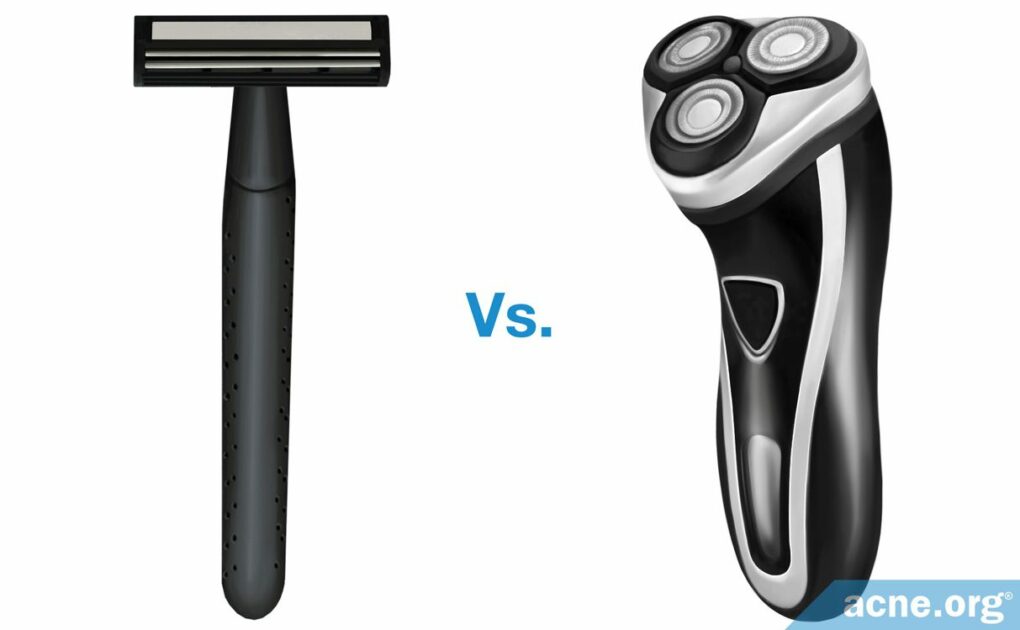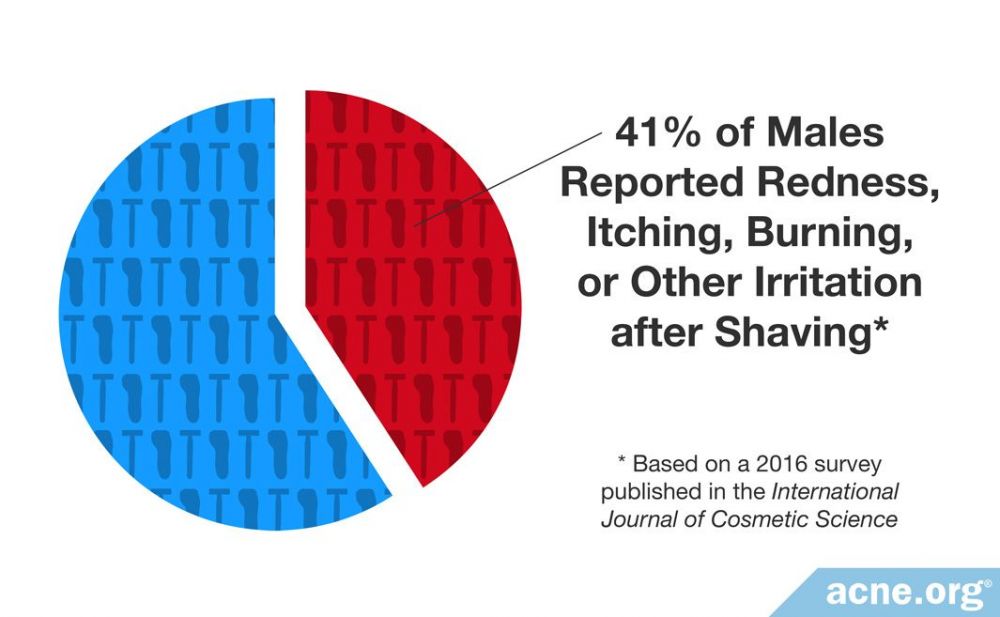When Done Properly, Blade Shaving Is Less Irritating, Especially for Acne-prone Skin

The Essential Info
Reducing irritation is the name of the game when it comes to shaving acne-prone skin.
There have only been three studies that look at irritation caused by blade shaving vs. electric shaving, and two out of three studies show no measurable difference. The third study, however, shows that more men reported irritation from blade shaving.
However, irritation from a blade shave depends a lot on the type of razor. Acne.org members over the years have found that using a 2-blade razor seems to produce much less irritation than electric razors.
My Personal Experience: I have tried over a dozen electric razors. No matter how strongly the electric razor advertises that it is “low-irritation” or “made for sensitive skin,” every one I have tried produces noticeable and immediate redness and irritation on my face, and particularly on my neck. I asked all of the other guys I work with at Acne.org to try as many electric razors as possible as well, and they all experienced the same thing.

The Science
- What Is Physical Irritation, and How Is Shaving Related to It?
- Scientific Studies: Razor Blade Vs. Electric Razor
- Shaving with a Razor Blade
- Shaving with an Electric Razor
- Acne.org’s Expert Opinion
When it comes to the best way to shave when you have acne, it all comes down to irritation. As long as you are not irritating your skin, you’re on the right track.
Dermatologists agree that physically irritating the skin is a major contributor to acne, so it’s important to shave as gently as possible and with the right razor.
As we will see, this means avoiding electric razors and opting for a blade razor instead, and shaving gently.
What Is Physical Irritation, and How Is Shaving Related to It?
Physical irritation, known as “mechanical irritation” in most dermatology textbooks, involves any form of physical irritation to the skin, including friction, tension, rubbing, and persistent pressure. The dermatology community agrees that physical irritation can lead to more acne and uses the term acne mechanica to describe acne caused by mechanically irritating the skin.1
Shaving includes some friction, tension, rubbing, and pressure to the skin, making it a suspect when it comes to physical irritation.
In one survey published in the International Journal of Cosmetic Science in 2016, we can see that many men experience physical irritation from shaving.2
Another study in the same journal reported that skin irritation from shaving is one of the most common cosmetic complaints by men in Europe and the U.S.3
How does this irritation from shaving affect acne?
Zooming in on how this irritation occurs on the skin surface, when a razor’s cutting edge contacts the skin, it can damage the topmost layer of skin cells called the skin barrier. People with acne tend to already have an impaired skin barrier when compared to people without acne, so it is particularly important for people with acne to keep this barrier as intact as possible.4,5
When the skin barrier is damaged, the skin releases inflammatory molecules. Acne is primarily an inflammatory disease, so anything that causes the release of inflammatory molecules–including shaving–can trigger an acne outbreak.
When it comes to shaving, irritation tends to be most pronounced on the neck, which has rougher skin compared to the face, but other areas of the face can also experience irritation.6
Long story short, we can see that it is important that acne-prone people are gentle with their skin and try to keep damage to the skin at a minimum.
Scientific Studies: Razor Blade Vs. Electric Razor
Three studies have compared irritation caused by blade razors with irritation caused by electric razors in men.
The first study, which was published in the Journal of the American Academy of Dermatology in 2006, enrolled 39 subjects, and its results were not statistically significant.7 In other words, with so few participants, any difference between the irritation caused by blade razors and the irritation caused by electric razors in the study may have been purely accidental.
The second study, published in the British Journal of Dermatology in 2012, included 90 participants, but again, no significant difference between blade shaving and electric shaving was reported.8
The third study, published in The Journal of Dermatology in 2021, suggested that blade shaving might actually cause more skin irritation than electric shaving. The study looked at questionnaires filled out by 340 men. Among men who used blade razors, 78.3% reported experiencing problems such as skin redness, skin dryness, razor burn, or cuts, while only 49.4% of men who used electric razors reported the same symptoms.9 However, since this study relied on questionnaires completed by the participants themselves without verification by a doctor or researcher, the results should be taken with a grain of salt.
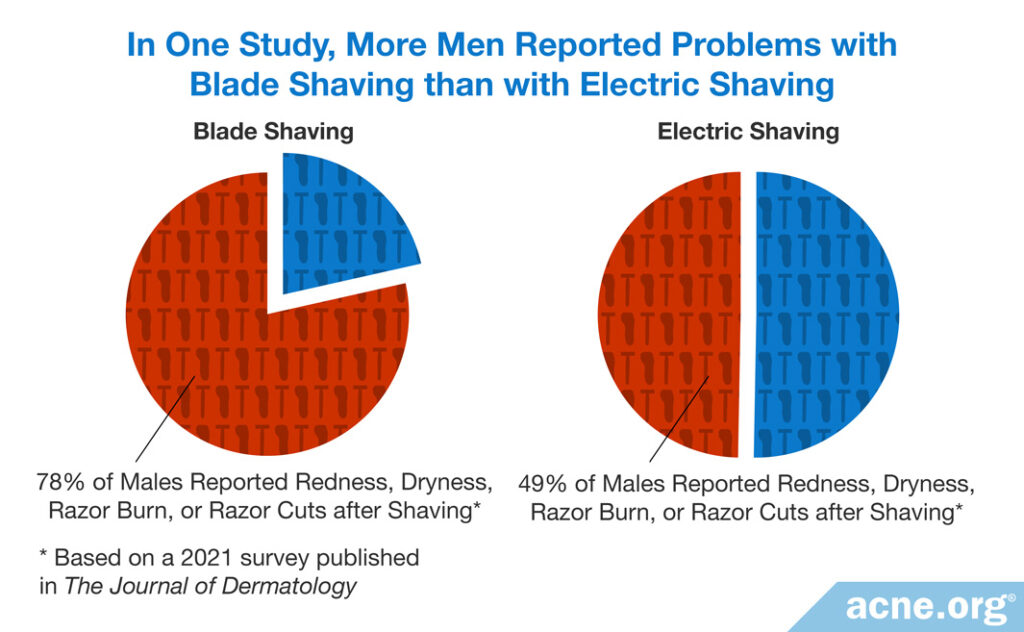
So in the absence of more hard data, we are unable to draw any conclusions from clinical studies.10
Instead, let’s have a closer look at the two shaving methods, including tips on how to get the most out of both.
Shaving with a Razor Blade
In the opinion of the MDs and PhDs on the Acne.org team, properly shaving with a razor blade causes less irritation than shaving with an electric razor, so long as a non-comedogenic (non-pore-clogging) shaving cream/gel/foam is used.
Shaving with a razor blade may also help with exfoliation of the skin, which can theoretically help with acne.11-13
Just beware of nicks: Shaving with a razor blade carries a greater risk of nicks when compared with electric razors, particularly if the blade contacts the skin with too much pressure or at the wrong angle. Most experts agree that the ideal angle for the blade is approximately 30 degrees. Don’t stress about using the perfect angle too much. Instead, staying “confident yet gentle” is a good way to go, making sure to use extra caution if shaving over acne lesions or ingrown hairs (also called razor bumps).
Side note: A razor blade also typically provides for a closer shave than an electric razor.
Tips for the best blade shave
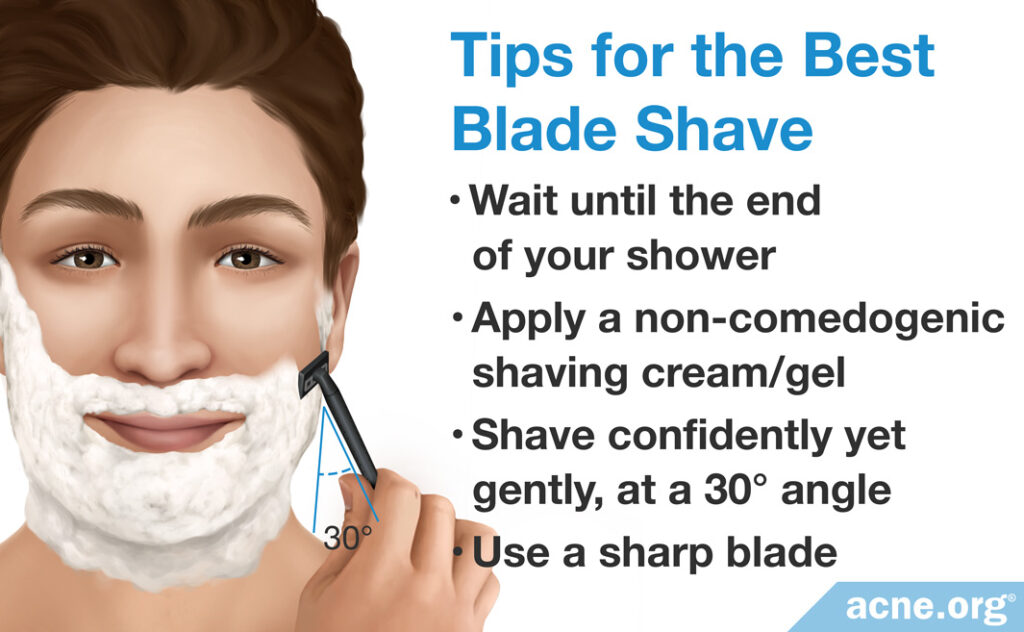
- Wait until the end of your shower because the water and steam will soften the hairs, making them easier to cut.
- Apply a shaving cream/gel/foam prior to shaving to lubricate the skin surface and allow for the blade to glide along the surface. Tip: Simply using the lather from a gentle facial cleanser is often just as lubricating and less expensive.
- Stay confident yet gentle while shaving. Do not use excessive force, and try to shave at a 30-degree angle.
- Use a sharp blade. The rule of thumb is to replace your blade every 2-4 weeks.
>> Tips on how to choose a razor
Shaving with an Electric Razor
The blades of electric razors do not actually contact the skin because they are separated from the skin by a foil. As the electric shaver moves over the face, hairs poke through small holes in the foil and are cut by spinning blades. While this may seem like it would be less irritating, in practice, it is not. Most men find that they experience more irritation, especially on the neck, when using an electric razor when compared to blade shaving.
On the bright side, most electric razors do not require wet skin or shaving cream (some wet-and-dry hybrid electric razors can be used with water).
Electric razors come in two types: foil and rotary. They have different names, but both have foils, and both are irritating.
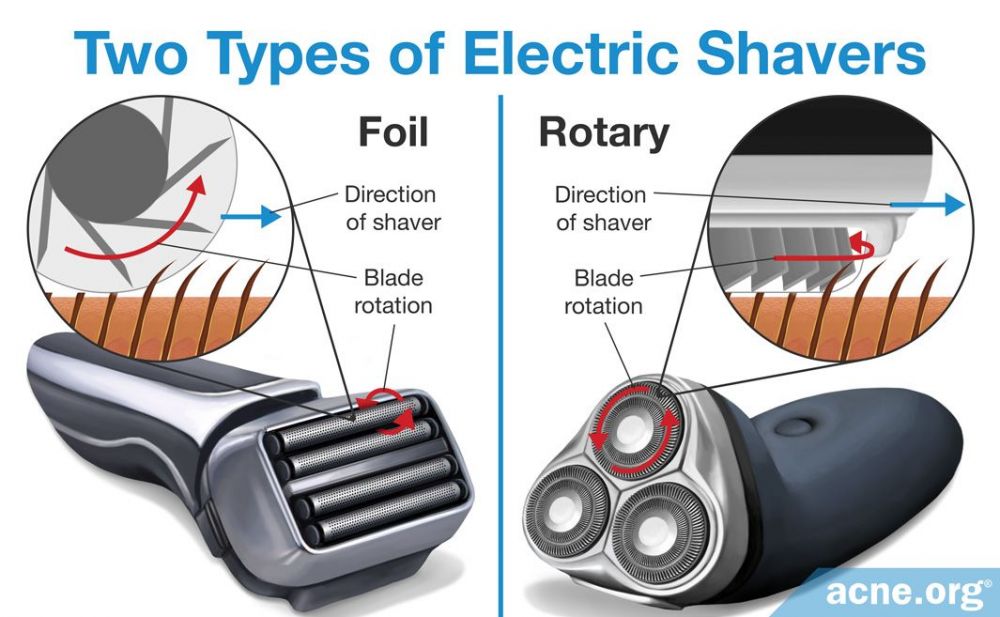
- Foil shavers contain up to four rows of parallel foils. Hairs poke through holes in the foils and are cut by spinning blades beneath the foil. The most common foil shavers hold two or three foils.
- Rotary shavers have round foils that are held in place by springs, usually three foils arranged in a triangular shape. The springs allow for the foils to conform to the curves of the face.
It might seem that electric razors would be gentler on the skin, but electric razors are actually more irritating, for two key reasons.
- Foils in electric razors produce heat after a short time of use, which can result in skin irritation. One way to alleviate this problem is to start shaving in the most sensitive area–typically the neck–before the foils become hot. While this may reduce the problem, heat generation cannot be eliminated.
- People tend to press too hard with electric razors. Most men prefer a close shave, but achieving this with an electric razor requires applying force against the skin to enable the hairs to poke deeply into the foils. Forceful contact with the skin causes physical irritation, which leads to increased susceptibility to inflammation and potentially more acne breakouts.
Tips for the best electric shave
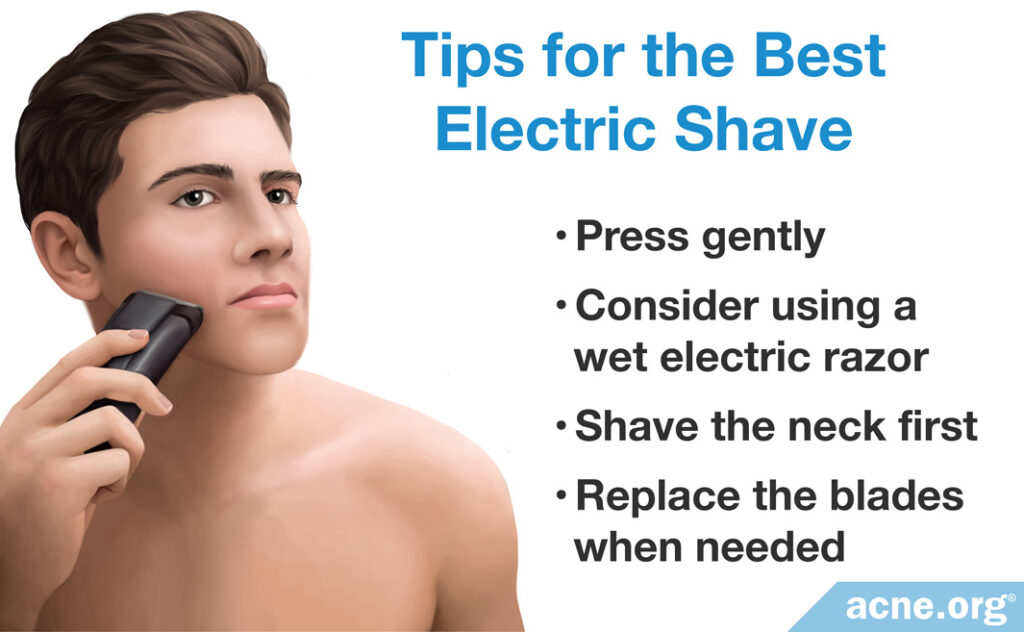
If you don’t have a blade razor around, or for any other reason really want to use an electric razor, follow these suggestions to reduce irritation:
- Press gently. Accept that the shave will not be as close and some stubble will remain. This is the tradeoff for avoiding irritation.
- Using a hybrid electric razor that can be used in water at the end of your shower might help. Water softens the hairs, making them easier to cut. However, even hybrid electric razors tend to be irritating, no matter how soft the hairs have become.
- Start shaving in the most sensitive area–usually the neck–before the foils have had a chance to heat up.
- Replace the blades of your razor according to the manufacturer’s recommendations. Blades become dull, causing more “pull” on the hair when it is being cut. Most electric razor manufacturers recommend replacing blades every year.
Acne.org’s Expert Opinion
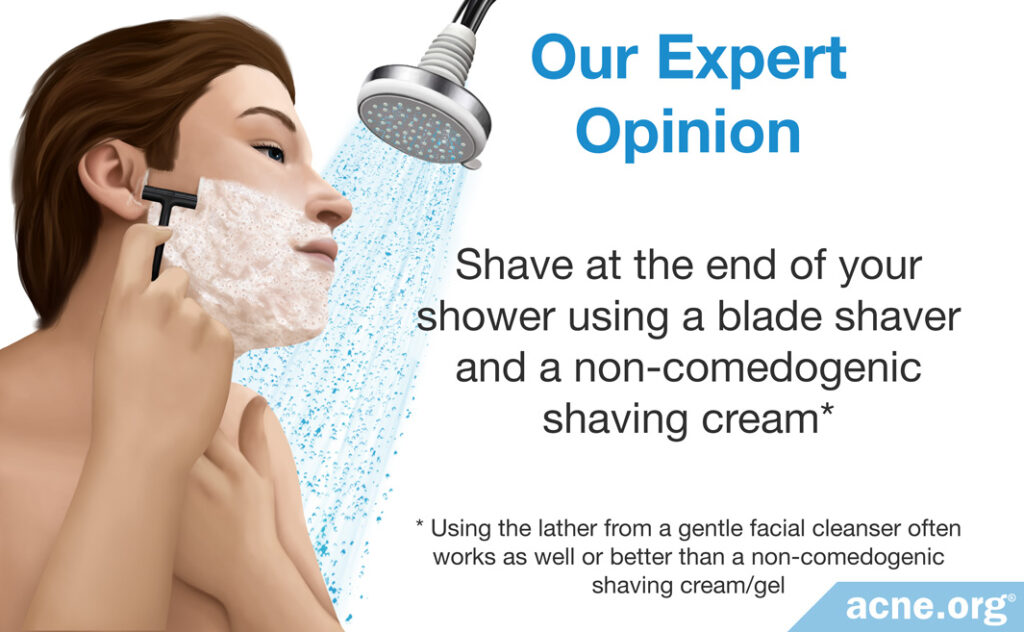
Since physical irritation of the skin aggravates acne, we recommend choosing the shaving method that best minimizes irritation to the skin. In our experience, this is traditional blade shaving. Electric razors are almost always irritating, particularly on the neck. Even when companies claim that their electric razor is “specifically designed for the neck” or “low-irritation,” it usually fails to live up to this claim. In contrast, blade shaving, when performed gently with a non-comedogenic shaving cream at the end of a shower, will provide for the least irritating shave.
References
- Mills, O. & Kligman, A. Acne mechanica. Arch Dermatol 111, 481 – 483 (1975). https://jamanetwork.com/journals/jamadermatology/article-abstract/534895
- Rietzler, M. et al. Innovative approaches to avoid electric shaving-induced skin Irritation. Int J Cosmet Sci 38, 10 – 16 (2016). https://onlinelibrary.wiley.com/doi/full/10.1111/ics.12329
- Cowley, K. & Vanoosthuyze, K. The biomechanics of blade shaving. Int. J. Cosmet Sci. 38 Suppl 1, 17-23 (2016). https://www.ncbi.nlm.nih.gov/pubmed/27212467
- Cowley, K. & Vanoosthuyze, K. Insights into shaving and its impact on skin. Br J Dermatol 166, 6 – 12 (2012). https://www.ncbi.nlm.nih.gov/pubmed/22385029
- Kubba, R. et al. Cosmetics and skin care in acne. Acne in India: Guidelines for Management – IAA Consensus Document. Indian J Dermatol Venereol Leprol 75, 1 – 62 (2009). http://www.ijdvl.com/article.asp?issn=0378-6323;year=2009;volume=75;issue=7;spage=55;epage=56;aulast=Kubba
- Maurer, M., Rietzler, M., Burghardt, R. & Siebenhaar, 1. The male beard hair and facial skin – challenges for shaving. Int. J. Cosmet. Sci. 38 Suppl 1, 3-9 (2016). https://www.ncbi.nlm.nih.gov/pubmed/27212465
- Fisher, E. et al. Preferred methods of excess hair removal in pediatric patients with lung transplantation. J Am Acad Dermatol 55, 320 – 323 (2006). https://www.jaad.org/article/S0190-9622(06)00836-X/pdf
- Wu, Y. et al. Skin characteristics of Chinese men and their beard removal habits. The British Journal of Dermatology 166, 17-21 (2012). https://pubmed.ncbi.nlm.nih.gov/22385031/
- Sukakul, T. et al. Facial hair shaving behavior and skin problems of shaved areas of males. The Journal of Dermatology 48, 1409-1413 (2021). https://pubmed.ncbi.nlm.nih.gov/34254359/
- Skin care for acne-prone skin. PubMed Health (2017). https://www.ncbi.nlm.nih.gov/pubmedhealth/PMH0072392/#i2077.behandlung-6m.shavingwetordry
- Debbarma, D. et al. Clinical review of deep cleansing apricot scrub: An herbal formulation. Int J Bioassays 4.9, 4251 – 4253 (2015). https://www.ijbio.com/articles/clinical-review-of-deep-cleansing-apricot-scrub-an-herbal-formulation.pdf
- Exfoliation (cosmetology). Wikipedia (2016). https://en.wikipedia.org/wiki/Exfoliation_(cosmetology)
- Howard, D. When razor meets skin: A scientific approach to shaving. The International Dermal Institute. http://myeducation.dermalinstitute.co.uk/us/library/16_article_When_Razor_Meets_Skin_A_Scientific_Approach_to_Shaving.html
 Acne.org Products
Acne.org Products